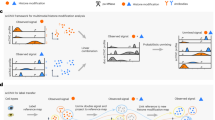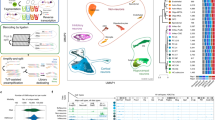Abstract
Histone modifications play an important role in chromatin organization and transcriptional regulation, but despite the large amount of genome-wide histone modification data collected in different cells and tissues, little is known about co-occurrence of modifications on the same nucleosome. Here we present a genome-wide quantitative method for combinatorial indexed chromatin immunoprecipitation (co-ChIP) to characterize co-occurrence of histone modifications on nucleosomes. Using co-ChIP, we study the genome-wide co-occurrence of 14 chromatin marks (70 pairwise combinations), and find previously undescribed co-occurrence patterns, including the co-occurrence of H3K9me1 and H3K27ac in super-enhancers. Finally, we apply co-ChIP to measure the distribution of the bivalent H3K4me3–H3K27me3 domains in two distinct mouse embryonic stem cell (mESC) states and in four adult tissues. We observe dynamic changes in 5,786 regions and discover both loss and de novo gain of bivalency in key tissue-specific regulatory genes, suggesting a functional role for bivalent domains during different stages of development. These results show that co-ChIP can reveal the complex interactions between histone modifications.
This is a preview of subscription content, access via your institution
Access options
Subscribe to this journal
Receive 12 print issues and online access
$209.00 per year
only $17.42 per issue
Buy this article
- Purchase on Springer Link
- Instant access to full article PDF
Prices may be subject to local taxes which are calculated during checkout





Similar content being viewed by others
References
Turner, B.M. Cellular memory and the histone code. Cell 111, 285–291 (2002).
Kouzarides, T. Chromatin modifications and their function. Cell 128, 693–705 (2007).
Creyghton, M.P. et al. Histone H3K27ac separates active from poised enhancers and predicts developmental state. Proc. Natl. Acad. Sci. USA 107, 21931–21936 (2010).
Shlyueva, D., Stampfel, G. & Stark, A. Transcriptional enhancers: from properties to genome-wide predictions. Nat. Rev. Genet. 15, 272–286 (2014).
Jenuwein, T. & Allis, C.D. Translating the histone code. Science 293, 1074–1080 (2001).
Strahl, B.D. & Allis, C.D. The language of covalent histone modifications. Nature 403, 41–45 (2000).
Dion, M.F., Altschuler, S.J. & Wu, L.F. Genomic characterization reveals a simple histone H4 acetylation code. Proc. Natl. Acad. Sci. USA 102, 5501–5506 (2005).
Schreiber, S.L. & Bernstein, B.E. Signaling network model of chromatin. Cell 111, 771–778 (2002).
Yan, L. et al. Epigenomic landscape of human fetal brain, heart, and liver. J. Biol. 291, 4386–4398 (2016).
Kundaje, A. et al. Integrative analysis of 111 reference human epigenomes. Nature 518, 317–330 (2015).
Bernstein, B.E. et al. A bivalent chromatin structure marks key developmental genes in embryonic stem cells. Cell 125, 315–326 (2006).
Grandy, R.A., Whitfield, T.W. & Wu, H. Genome-wide studies reveal that H3K4me3 modification in bivalent genes is dynamically regulated during the pluripotent cell cycle and stabilized upon differentiation. Mol. Cell Biol. 36, 615–627 (2015).
Ernst, J. et al. Mapping and analysis of chromatin state dynamics in nine human cell types. Nature 473, 43–49 (2011).
Ernst, J. & Kellis, M. ChromHMM: automating chromatin-state discovery and characterization. Nat. Methods 9, 215–216 (2012).
Guan, X., Rastogi, N., Parthun, M.R. & Freitas, M.A. Discovery of histone modification crosstalk networks by stable isotope labeling of amino acids in cell culture mass spectrometry (SILAC MS). Mol. Cell. Proteomics 12, 2048–2059 (2013).
Britton, L., Gonzales-Cope, M. & Zee, B.M. Breaking the histone code with quantitative mass spectrometry. Expert Rev. Proteomics 8, 631–643 (2011).
Lara-Astiaso, D. et al. Immunogenetics. Chromatin state dynamics during blood formation. Science 345, 943–949 (2014).
Egelhofer, T.A. et al. An assessment of histone-modification antibody quality. Nat. Struct. Mol. Biol. 18, 91–93 (2011).
Ghisletti, S. et al. Identification and characterization of enhancers controlling the inflammatory gene expression program in macrophages. Immunity 32, 317–328 (2010).
Heinz, S. et al. Simple combinations of lineage-determining transcription factors prime cis-regulatory elements required for macrophage and B cell identities. Mol. Cell 38, 576–589 (2010).
Whyte, W.A. et al. Master transcription factors and mediator establish super-enhancers at key cell identity genes. Cell 153, 307–319 (2013).
Furlan-Magaril, M. & Rincón-Arano, H. Sequential chromatin immunoprecipitation protocol: ChIP-reChIP. Methods Mol. Biol. 543, 253–266 (2009).
Kumar, R.M. et al. Deconstructing transcriptional heterogeneity in pluripotent stem cells. Nature 516, 56–61 (2014).
Garber, M. et al. A high-throughput chromatin immunoprecipitation approach reveals principles of dynamic gene regulation in mammals. Mol. Cell 47, 810–822 (2012).
Thea A Egelhofer, T.A. An assessment of histone-modification antibody quality. Nat. Struct. Mol. Biol. 18, 91–93 (2011).
Acknowledgements
We thank G. Brodsky for art work. I.A. is supported by the European Research Council (309788), the Israel Science foundation (782/11) and the BLUEPRINT FP7 consortium, the Ernest and Bonnie Beutler Research Program of Excellence in Genomic Medicine, a Minerva Stiftung research grant, and the National Human Genome Research Institute Center for Excellence in Genome Science (1P50HG006193), the Israeli Ministry of Science, Technology and Space, the David and Fela Shapell Family Foundation, and the Abramson Family Center for Young Scientists. I.A. is the incumbent of the Alan and Laraine Fischer Career Development Chair.
Author information
Authors and Affiliations
Contributions
A.W., D.L.-A. and I.A. conceived and designed this study. D.L.-A. conducted the co-ChIP experiments. D.L.-A., with help from V.K., O.G. and J.H.H., conducted mESC tissue culture experiments. A.W., with support from D.L.-A. and I.A., designed the computational methods. A.W., with help from E.D., developed and implemented these methods and performed data analysis. I.A., A.W. and D.L.-A. wrote the manuscript with contributions from all authors.
Corresponding author
Ethics declarations
Competing interests
The authors declare no competing financial interests.
Integrated supplementary information
Supplementary Figure 1
(a) Profiles of conventional ChIP and Co-ChIP for the TNF locus (top) and Ebf1 locus (bottom). Single ChIP of H3K4me3 (green), H3K27ac (blue) and H3K27me3 (red), and Co-ChIP profiles in both IP orders of active promoters (H3K4me3-H3K27ac, H3K27ac-H3K4me3), poised promoters (H3K4me3-H3K27me3, H3K27me3-H3K4me3) and mutually exclusive PTMs (H3K27ac-H3K27me3) as control. (b) Scatterplot of conventional ChIP read counts for H3K27ac (x-axis) and H3K4me3 (y-axis) using 1kb sliding windows across the genome. Colors represent enriched Co-ChIP signal in the given window, purple for H3K27me3-H3K4me3, red for H3K27ac-H3K4me1 and cyan for H3K27ac-H3K4me3. Windows without Co-ChIP enrichment are marked in black. (c) Co-ChIP profiles for TF-PTM pairs as described in main Fig. 1e for Nfkb locus.
Supplementary Figure 2 Co-ChIP is robust to order of antibodies
(a) Genome browser view for Hoxa locus showing CO-ChIP data for H3K4me3-H3K27me3 and H3K27me3-H3K4me3 (b) Scatterplot comparing Co-ChIP reads counts of the pair H3K4me21Ab-H3K27ac2Ab compared to switching the order of antibodies to H3K27ac1Ab-H3K4me22Ab (c–e) same as (b) for H3K4me3-H3K27me3, H3K27ac-H3K4me1 and H3K4me2-H3K27me3 respectively.
Supplementary Figure 3 Analysis of Co-ChIP profiling for 70 PTM pairs
(a) Read counts of 14 PTMs using H3 as secondary antibody. (b) Comparison of relative read abundance of 14 PTMs in H3K27ac pool to the conventional ChIP pairwise correlation between each PTM and H3K27ac. (c) Overlap percentage of super-enhancer regions (defined from Med12, PU.1 and Cebpb ChIP-seq in BMDC24 in the 15 clusters presented in Fig. 2b. (d) Heatmap showing the signal for each single ChIP over the Kmeans (k=15) clustering shown in Figure 2b. (e) Scatterplot of Co-ChIP control reads counts for H3K36me3 and H3K4me3 with H3 as the second antibody. Color scale represents the read counts from H3K36me3-H3K4me3 Co-ChIP. (f) Scatterplot of Co-ChIP control reads counts for H3K27ac and H3K18ac with H3 as the second antibody. Color scale represents the read counts from H3K27ac-H3K18ac Co-ChIP.
Supplementary Figure 4 Multiplicative model to predict expected co-occurrence from conventional ChIP data
(a-d) Scatterplots showing two single ChIP counts for H3K27ac (x-axis) and H3K4me2 (y-axis) in colors: (a) Co-ChIP data for H3K27ac–H3K4me2. (b) Simple multiplicative model with one scaling factor. (c) Multiplicative model with exponential scaling factors and linear scaling factor. (d) k-nearest neighbors smoothing with Gaussian kernel for K=100. (e-g) scatterplots showing Co-ChIP data vs. multiplicative model, Multiplicative model with exponential scaling and k-nearest neighbors smoothing as described in b-d. (h) Histogram showing distance from TSS for region with exclusive or inclusive interactions between H3K4me1 and H3K27ac. (i) Same as h for H3K4me2 and H3K27ac (j) Same as (h) for H3K4me3 and H3K27ac
Supplementary Figure 5 Characterization of bivalent vs. active domains in primed ES cells (Serum/LIF)
(a) Scatterplot showing Co-ChIP read counts for bivalent (H3K27me3-H3K4me3) vs. active (H3K27ac-H3K4me3) domains in primed ES cells (Serum/LIF). Color scale indicates the level of expression noise as measured from single cells mRNA profiling in Kumar et al.23 (b) GO enrichment categories for primed ES bivalent domain ranked by decreasing q-value order (as retrieved from GOrilla).
Supplementary information
Supplementary Figures
Supplementary Figures 1–5 (PDF 8077 kb)
Rights and permissions
About this article
Cite this article
Weiner, A., Lara-Astiaso, D., Krupalnik, V. et al. Co-ChIP enables genome-wide mapping of histone mark co-occurrence at single-molecule resolution. Nat Biotechnol 34, 953–961 (2016). https://doi.org/10.1038/nbt.3652
Received:
Accepted:
Published:
Issue Date:
DOI: https://doi.org/10.1038/nbt.3652
This article is cited by
-
A low-input high resolution sequential chromatin immunoprecipitation method captures genome-wide dynamics of bivalent chromatin
Epigenetics & Chromatin (2024)
-
Regulation, functions and transmission of bivalent chromatin during mammalian development
Nature Reviews Molecular Cell Biology (2023)
-
Cocaine regulation of Nr4a1 chromatin bivalency and mRNA in male and female mice
Scientific Reports (2022)
-
Cellular macromolecules-tethered DNA walking indexing to explore nanoenvironments of chromatin modifications
Nature Communications (2021)
-
COMPASS and SWI/SNF complexes in development and disease
Nature Reviews Genetics (2021)



